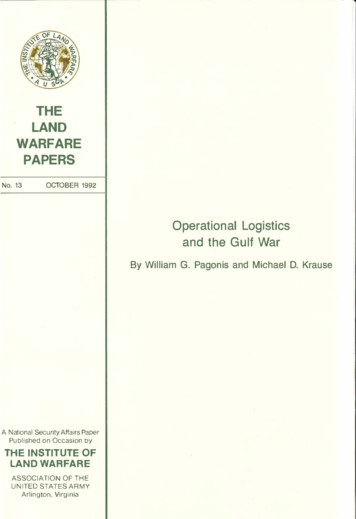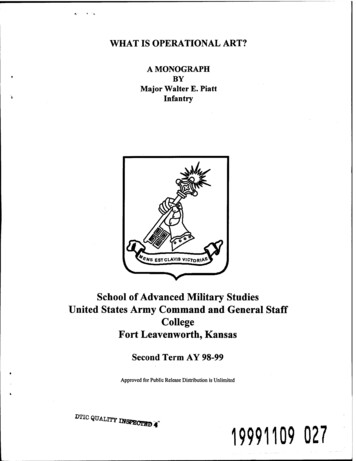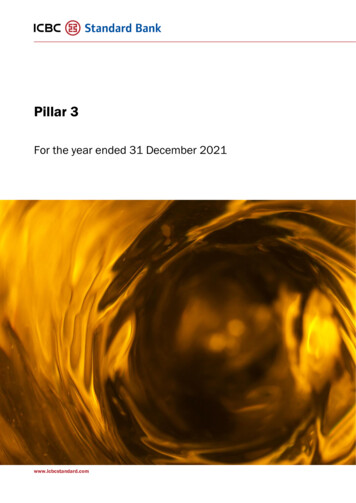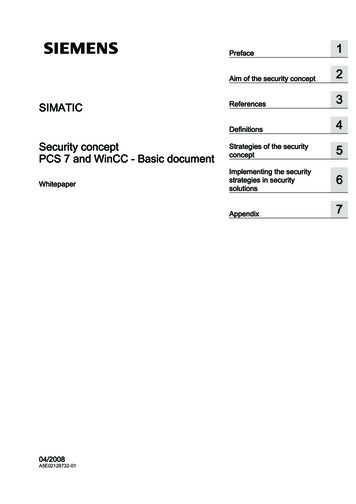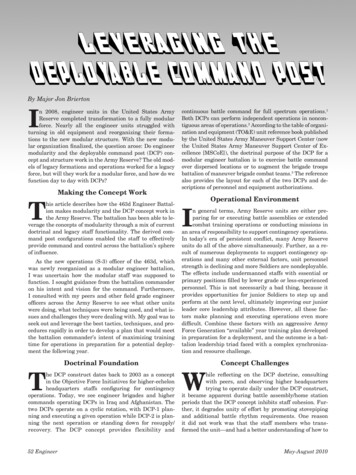
Transcription
By Major Jon BriertonIn 2008, engineer units in the United States ArmyReserve completed transformation to a fully modularforce. Nearly all the engineer units struggled withturning in old equipment and reorganizing their formations to the new modular structure. With the new modular organization finalized, the question arose: Do engineermodularity and the deployable command post (DCP) concept and structure work in the Army Reserve? The old models of legacy formations and operations worked for a legacyforce, but will they work for a modular force, and how do wefunction day to day with DCPs?TMaking the Concept Workhis article describes how the 463d Engineer Battalion makes modularity and the DCP concept work inthe Army Reserve. The battalion has been able to leverage the concepts of modularity through a mix of currentdoctrinal and legacy staff functionality. The derived command post configurations enabled the staff to effectivelyprovide command and control across the battalion’s sphereof influence.continuous battle command for full spectrum operations.1Both DCPs can perform independent operations in noncontiguous areas of operations.2 According to the table of organization and equipment (TO&E) unit reference book publishedby the United States Army Maneuver Support Center (nowthe United States Army Maneuver Support Center of Excellence [MSCoE]), the doctrinal purpose of the DCP for amodular engineer battalion is to exercise battle commandover dispersed locations or to augment the brigade troopsbattalion of maneuver brigade combat teams.3 The referencealso provides the layout for each of the two DCPs and descriptions of personnel and equipment authorizations.IOperational EnvironmentAs the new operations (S-3) officer of the 463d, whichwas newly reorganized as a modular engineer battalion,I was uncertain how the modular staff was supposed tofunction. I sought guidance from the battalion commanderon his intent and vision for the command. Furthermore,I consulted with my peers and other field grade engineerofficers across the Army Reserve to see what other unitswere doing, what techniques were being used, and what issues and challenges they were dealing with. My goal was toseek out and leverage the best tactics, techniques, and procedures rapidly in order to develop a plan that would meetthe battalion commander’s intent of maximizing trainingtime for operations in preparation for a potential deployment the following year.n general terms, Army Reserve units are either preparing for or executing battle assemblies or extendedcombat training operations or conducting missions inan area of responsibility to support contingency operations.In today’s era of persistent conflict, many Army Reserveunits do all of the above simultaneously. Further, as a result of numerous deployments to support contingency operations and many other external factors, unit personnelstrength is declining and more Soldiers are nondeployable.The effects include undermanned staffs with essential orprimary positions filled by lower grade or less-experiencedpersonnel. This is not necessarily a bad thing, because itprovides opportunities for junior Soldiers to step up andperform at the next level, ultimately improving our juniorleader core leadership attributes. However, all these factors make planning and executing operations even moredifficult. Combine these factors with an aggressive ArmyForce Generation “available” year training plan developedin preparation for a deployment, and the outcome is a battalion leadership triad faced with a complex synchronization and resource challenge.Doctrinal FoundationConcept ChallengesThe DCP construct dates back to 2003 as a conceptin the Objective Force Initiatives for higher-echelonheadquarters staffs configuring for contingencyoperations. Today, we see engineer brigades and highercommands operating DCPs in Iraq and Afghanistan. Thetwo DCPs operate on a cyclic rotation, with DCP-1 planning and executing a given operation while DCP-2 is planning the next operation or standing down for resupply/recovery. The DCP concept provides f lexibility and52 EngineerWhile reflecting on the DCP doctrine, consultingwith peers, and observing higher headquarterstrying to operate daily under the DCP construct,it became apparent during battle assembly/home stationperiods that the DCP concept inhibits staff cohesion. Further, it degrades unity of effort by promoting stovepipingand additional battle rhythm requirements. One reasonit did not work was that the staff members who transformed the unit—and had a better understanding of how toMay-August 2010
Form ApprovedOMB No. 0704-0188Report Documentation PagePublic reporting burden for the collection of information is estimated to average 1 hour per response, including the time for reviewing instructions, searching existing data sources, gathering andmaintaining the data needed, and completing and reviewing the collection of information. Send comments regarding this burden estimate or any other aspect of this collection of information,including suggestions for reducing this burden, to Washington Headquarters Services, Directorate for Information Operations and Reports, 1215 Jefferson Davis Highway, Suite 1204, ArlingtonVA 22202-4302. Respondents should be aware that notwithstanding any other provision of law, no person shall be subject to a penalty for failing to comply with a collection of information if itdoes not display a currently valid OMB control number.1. REPORT DATE3. DATES COVERED2. REPORT TYPEAUG 201000-00-2010 to 00-00-20104. TITLE AND SUBTITLE5a. CONTRACT NUMBERLeveraging the Deployable Command Depot5b. GRANT NUMBER5c. PROGRAM ELEMENT NUMBER6. AUTHOR(S)5d. PROJECT NUMBER5e. TASK NUMBER5f. WORK UNIT NUMBER7. PERFORMING ORGANIZATION NAME(S) AND ADDRESS(ES)Army Engineer School,Engineer Professional Bulletin,464 MANSCENBldg 3201 Ste 2661,Fort Leonard Wood,MO,654739. SPONSORING/MONITORING AGENCY NAME(S) AND ADDRESS(ES)8. PERFORMING ORGANIZATIONREPORT NUMBER10. SPONSOR/MONITOR’S ACRONYM(S)11. SPONSOR/MONITOR’S REPORTNUMBER(S)12. DISTRIBUTION/AVAILABILITY STATEMENTApproved for public release; distribution unlimited13. SUPPLEMENTARY NOTES14. ABSTRACT15. SUBJECT TERMS16. SECURITY CLASSIFICATION OF:a. REPORTb. ABSTRACTc. THIS PAGEunclassifiedunclassifiedunclassified17. LIMITATION OFABSTRACT18. NUMBEROF PAGESSame asReport (SAR)419a. NAME OFRESPONSIBLE PERSONStandard Form 298 (Rev. 8-98)Prescribed by ANSI Std Z39-18
UMTbattalion commandercommanddeployable command postevacuationHeadquarters and Headquarters Companyintelligencepersonnel service companyadjutantintelligenceoperations and trainingsupplycommunicationsmedical treatment sectionunit ministry teamFigure 1operate under the modular concepts—were gone, due topromotions and other transfers. The new staff membersdid not fully grasp the new concepts and complexities ofoperating under the DCP construct. Another reason wasthat there were not enough Soldiers assigned, and thebattalion could not afford to have the staff split and goingin two separate directions. Staffs operate better under alegacy construct and mentality because it is familiar andhas proven to work efficiently. However, when the battalion transitions from a training focus to an operational focus conducting split-based or decentralized operations, theDCP concept works because it provides flexibility and effective command and control.AConcept Incorporations the start of the new training year approached,the battalion staff developed an aggressive plan.to leverage training events in order to set conditions for a potential deployment while continually strivingto improve readiness. The MSCoE unit reference book provides a doctrinal DCP organizational template that is inline with the unit manning roster. However, this configuration does not always fit every situation. The first order ofMay-August 2010business was to develop DCP structures that would best fitthe battalion’s situation and training plan for both normaland split-based operations (Figure 1). For normal operational periods, the staff was configured in legacy functionalroles with the executive officer (XO) in charge of the adjutant and supply staff primary officers, and the S-3 officer was in charge of the intelligence, communications, andS-3 section (which included plans). This staff configurationwould not work for split-based operations, because not allstaff functions reside under one of the battalion field gradeofficers. Many other situations and external influences required alterations to the standard DCP structure as well.For instance, according to doctrine, the DCP-1 commanderis the battalion XO. However, in this instance, the XO wasnot available for the mission, so the battalion commanderled DCP-1 and the S-3 officer led DCP-2.One of the key attributes of modularity is tailorable “plugand-play” functionality. The DCP offers the same tailorableflexibility. The DCP-1 staff was formulated and manned withapproximately 14 personnel to achieve command and controlof engineer forces conducting construction operations to support Operation Beyond the Horizons in Honduras. Logisticians who focused their efforts on providing operational andEngineer 53
463 EN BN (DCP1)463 EN BN (DCP2)Legend:CSTCDCPEN CO (H)EN CO (V)MRBCPlan ConfCombat Service Training Centerdeployable command postengineer company (horizontal)engineer company (vertical)multirole bridge companyplanning conferenceFigure 2engineer logistic support to the Beyond the Horizons rotational task force comprised the majority of the DCP-1 staff.To manage expectations and provide some predictability, thebattalion developed a phased approach to meeting traininggoals, fulfilling operational requirements, and meeting thecommander’s intent (Figure 2).Phase I. During this phase, the plan established expectations and provided task and purpose for the battalion andall of the subordinate units by phase. The battalion operated along legacy functional staff lines and maintained thenormal battle rhythm.Phase II. As we approached Phase II, battle rhythm requirements increased, and we transitioned into DCP staffconfigurations. During Phase II-A, the battalion commander and hisDCP-1 staff deployed to Honduras to support OperationBeyond the Horizons, while I led DCP-2, consisting ofthe remainder of the staff, in Wheeling, West Virginia.DCP-2 was responsible for maintaining situationalawareness and battle tracking of DCP-1 in Hondurasand the 336th Engineer Company in Germany. DCP-2was also setting conditions for subordinate unit extended combat training while conducting day-to-dayoperations and preparing for our deployment to Camp54 EngineerDawson, West Virginia, to support Operation SuperEcho, the 412th Theater Engineer Command’s course tocombine military occupational specialty (MOS) 21J,vertical construction operator, with MOS 21E, horizontalconstruction operator. During Phase II-B, DCP-2 deployed to Camp Dawson and hosted Operation Super Echo while concurrently providing tactically focused extended combat training for headquarters and field service companies andmaintaining situational awareness and battle trackingacross the battalion. Midway through Phase II-B,DCP-1 redeployed to the continental United States andjoined DCP-2 at Camp Dawson. With both the command posts together at Camp Dawson under the battalion commander, the staff reassembled and resumednormal functionality and planned for future operationsfor the remainder of training year 2009 and the firstquarter of training year 2010.TLessons Learnedo meet the commander’s intent and improve readiness across the battalion, the major points to makethe DCP concept work are to—May-August 2010
Alter the task organization to fit the situation in orderto leverage flexibility during split-based or decentralized operations. Operate as a legacy functional staff during normal operational periods with the XO or DCP-1 commanderoverseeing the adjutant and supply staff sections, whilethe S-3 or DCP-2 commander oversees the intelligence,S-3, and communications staff sections. Synchronize staffs jointly between the XO at DCP-1 andthe S-3 at DCP-2. Develop depth on the bench by empowering NCOsthrough cross-training in multiple staff section roleswhile inculcating the traits of agility and flexibility. Ensure staff situational awareness and understandingby maintaining a common operational picture and battle rhythm.Ultimately, the DCP concept was designed to enableflexibility and provide continuous battle command. Thisdoes not necessarily mean that DCP-1 is the day shift andDCP-2 is the night shift or vice versa. However, they couldfunction that way if the situation dictated.TConclusionhe DCP construct, coupled with synchronized staffactions, enables the battalion to maintain unity ofeffort during split-based operations or deploymentswhile retaining agility and flexibility. Although not thetextbook example, the 463d Engineer Battalion was ableto leverage the capabilities of the DCP concept and the junior staff to meet the commander’s intent. Furthermore,through executing the lessons learned, the 463d improvedreadiness within the battalion and across the 412th Theater Engineer Command.“Hammer On, Drive It Home!”Major Brierton is the executive officer of the 463d Engineer Battalion. He has served as the chief of operations forthe 412th Theater Engineer Command, deployed to Iraq asthe plans officer and battle captain for the 983d EngineerBattalion, and commanded a light equipment engineer company. He is a graduate of the United States Army Commandand General Staff College, Fort Leavenworth, Kansas, andholds a master’s in organizational management from theUniversity of Phoenix.EndnotesField Manual 3-34, Engineer Operations, April 2009,p. 2-9.12United States Army Training and Doctrine Command(TRADOC) Pamphlet 525-3-01, United States Army ObjectiveForce Battle Command (C4ISR) Concept, 2003, p. 43.3Maneuver Support Table of Organization and EquipmentReference Book, United States Army Maneuver Support Center of Excellence, Fort Leonard Wood, Missouri, April 2008,p. 9-22.
for the remainder of training year 2009 and the first quarter of training year 2010. T o meet the commander's intent and improve readi-ness across the battalion, the major points to make the DCP concept work are to— 54 Engineer May-August 2010 Figure 2 Legend: CSTC Combat Service Training Center DCP deployable command post



